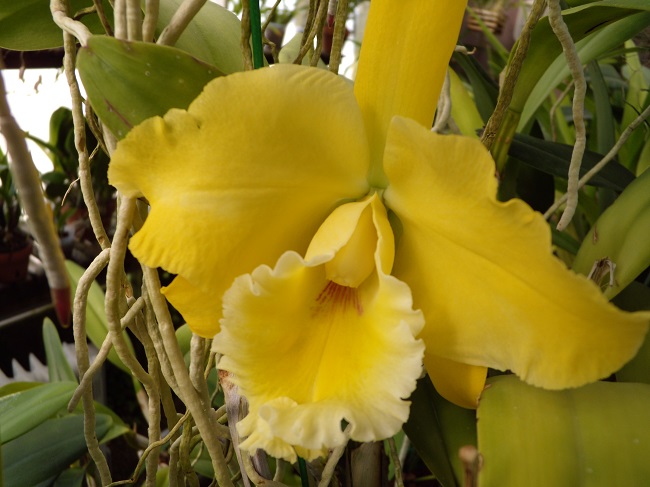
If after threatening to toss them into the compost pile doesn’t work and assuming your plants are otherwise healthy, why is it some plants just won’t bloom?
The answer is a bit more than food, light and water and a lot more like food, light, water, temperature, temperature differentiation and a rest period or dry period.
Most Orchids in their natural habitat, experience definite wet and dry seasons. Summers are usually hot, humid, and wet, while winters are warm and dry. It is generally these cycles that induce a plant to bloom.
Cattleyas and Other Warm to Intermediate Growers
Given abundant light, water, and food during the growing season (approx. March thru September) your plants have hardened their new growth, the pseudo bulbs are healthy and plump and maybe or maybe not, developed a sheath to protect the awaiting flower buds. However, without a certain and definite difference in temperature between night and day, chances are the plant won’t set any buds. Your Orchid depends upon temperature variations and day length, to let it know it’s time to stop growing and start producing flowers. Typically, a plant growing in a daytime temperature of 85° to 90° will require at least a 20° difference in a nighttime temperature to initiate bud set. Watering should also be greatly reduced, come fall and winter. A once or twice a month watering should keep the plant from desiccation. With some genera of Orchids, watering should be totally eliminated until new growth is seen in early spring, since the plant is no longer actively growing and entering a sort of “dormancy”. In certain parts of the country, you may also need to remove the greenhouse shade cloth, in order to compensate for the lack and sun and light due to the shorter days.
Phalaenopsis and Other Warm Growers
While basically the same cultural requirements apply for the Phals, some distinct differences are apparent. Since these monopodial orchids can’t store water, they shouldn’t be allowed to dry out for long periods of time. Early fall should begin to coax your plants into spike again, and it is important to create some sort of temperature deviation at night to initiate spike. Paphiopediums and Phrags are also preparing to bud, the same situation applies here as far as the watering goes, don’t let the plants remain dry for any length of time.
Cymbidiums and All Other Cool Growers
Cymbidiums are very popular plants to grow, but unless you are fortunate to live along the southwestern coast of California, where you can often find these plants growing outside directly in garden beds, then these plants are best suited to either a cool shade house or a controlled cool greenhouse. Growing profusely during the summer months, these hybrids also depend upon a very distinct difference between daytime and nighttime temperatures. In addition, fertilizing during the spring and summer months, with a high nitrogen fertilizer, must stop by June then resume feeding with a low nitrogen, high Potassium fertilizer until February to help initiate spike. Hybridizers of these gorgeous plants has given collectors a much broader and longer blooming season, typically well into early summer.
If none of the above methods makes a bit of difference in getting your plants to bloom, then by all means feel free to give them the heave ho directly to the compost pile.
Happy Growing! Tom Capranica has been a hobby collector and hybridizer of Orchids for over 20 years, and an active member of the American Orchid Society for about the same length of time. He grows his Orchids in a 450 sq. ft. climate-controlled greenhouse, containing over 300 plants of various genera, primarily Cattleya.
Related Articles & Free Email Newsletter
Cymbidiums, The Orchid That Made the Corsage Famous
How to Divide and Conquer Your Orchids
How to Water and Feed Orchids During the Summer and Fall Months




Comment here